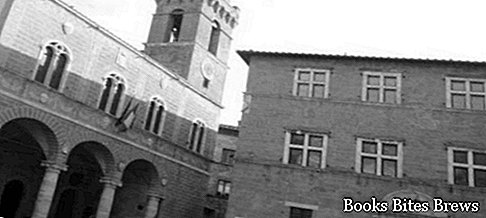What to see in Pienza, itinerary including the main monuments and places of interest, including the Duomo, Palazzo Piccolomini and the Church of San Francesco.
Tourist information
City of Tuscany in the province of Siena, Pienza lays alone on top of a hill, surrounded by the beautiful landscape of the Val d'Orcia, in the heart of the Sienese countryside.
This beautiful Renaissance town, a splendid example of architecture and town planning of the fifteenth century, before 1462 was a small village called Corsignano, whose particularity was that of having given birth, in 1405, to Enea Silvio Piccolomini, who in 1458 will be elected Pope with name of Pius II.
This event changed the fate of the village, in fact between 1459 and 1462, Pope Pius II entrusted the famous architect Bernardo Rossellino with the task of transforming the modest birthplace into the harmonious town, his "ideal city" of the Renaissance, changing the name in Pienza.
Its historic center has been declared a UNESCO World Heritage Site.
Around the suggestive square dedicated to Pius II are the main monuments of the city, including the Duomo, Palazzo Piccolomini, Palazzo Borgia and Palazzo Pubblico, also called Palazzo dei Priori.
The Cathedral, dedicated to Our Lady of the Assumption, was erected between 1459-1462 in the place of the ancient Romanesque church, designed by Rossellino, who was inspired by the most advanced Renaissance canons for the facade.
The bright Gothic interior with three aisles of equal height was inspired by the German and Austrian "Hallenkirchen", which Pius II had admired on his travels in Central Europe.
Numerous works of art adorn the Cathedral, specially commissioned by Pius II to the greatest Sienese painters of the time, including Giovanni di Paolo, Matteo di Giovanni, Lorenzo di Pietro, known as Vecchietta and Sano di Pietro.
Palazzo Piccolomini was built by demolishing the buildings that were on the right side of the square.
The palace was wanted by Pius II as a home for himself and his family.
Recommended readings- Artimino (Tuscany): what to see
- San Galgano (Tuscany): what to see
- Poggibonsi (Tuscany): what to see
- Castiglione di Garfagnana (Tuscany): what to see
- Tuscany: Sunday day trips
For its realization Rossellino was inspired by the Palazzo Rucellai in Florence, the work of his master Leon Battista Alberti.
The facade has three superimposed orders, covered with smooth ashlar.
In the part facing the countryside there is a three-storey loggia, which offers a splendid view of the roof garden, the Val d'Orcia and Monte Amiata.
The rooms on the first floor retain the character of a patrician residence of the '400, with valuable antiques of art and craftsmanship.
What see
Palazzo Borgia, now the seat of the Episcopate, is located on the left side of the square, opposite Palazzo Piccolomini.
The ancient Gothic building was donated by Pope Pius II to Cardinal Rodrigo Borgia, his close collaborator who later became Pope Alexander VI, who restructured it and made it his own residence.
On the corner you can see the Borgia coat of arms.
In the palace there is the Diocesan Museum, which houses the Piviale di Pio II, an extraordinary masterpiece created with a decorative embroidery system called opus anglicanum, made of polychrome silk and silver.
The Palazzo Pubblico, currently the seat of the municipal administration, was the ancient residence of the Priors.
It is located on Piazza Pio II, in front of the Duomo and is one of the most recent buildings overlooking the square.
The Palace is made entirely of travertine, with a loggia on the ground floor, while on the right side it has a brick tower lower than the bell tower of the Cathedral, to highlight the greater importance of ecclesiastical power over the civil one.
Inside the Palace, in the Council Room, there is a fresco of the Sienese School of the '400, depicting the Madonna and Child and the patrons of Pienza San Vito, San Modesto and San Matteo.
The Church of San Francesco is the only important building left in the ancient village of Corsignano, located inside the city walls.
Gothic in shape, it dates back to the second half of the thirteenth century.
The single-nave interior contains important remains of fourteenth-century frescoes, which illustrate the life of San Francesco.
Other palaces to see are that of the Ammannati, the Gonzaga and the Cardinal Atrebatense, which perfectly complement the fascinating urban fabric of Pienza.




